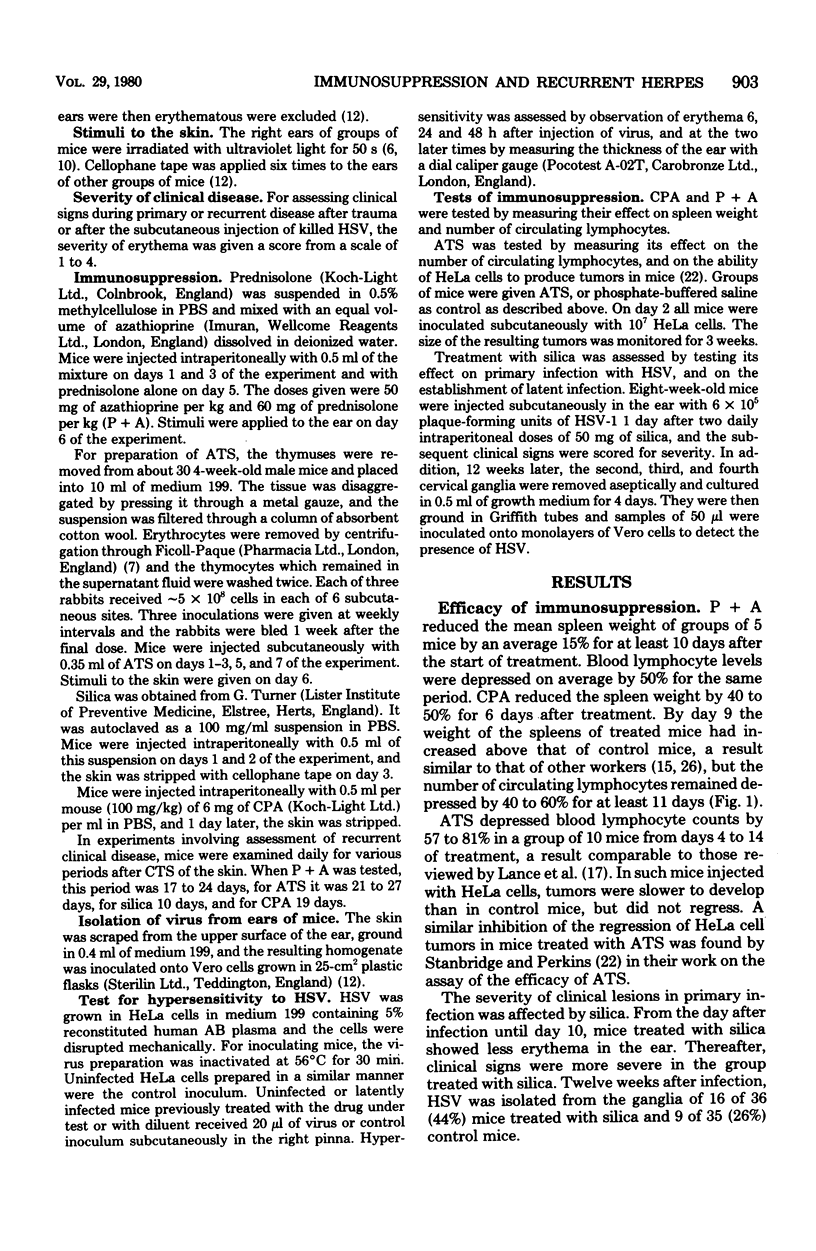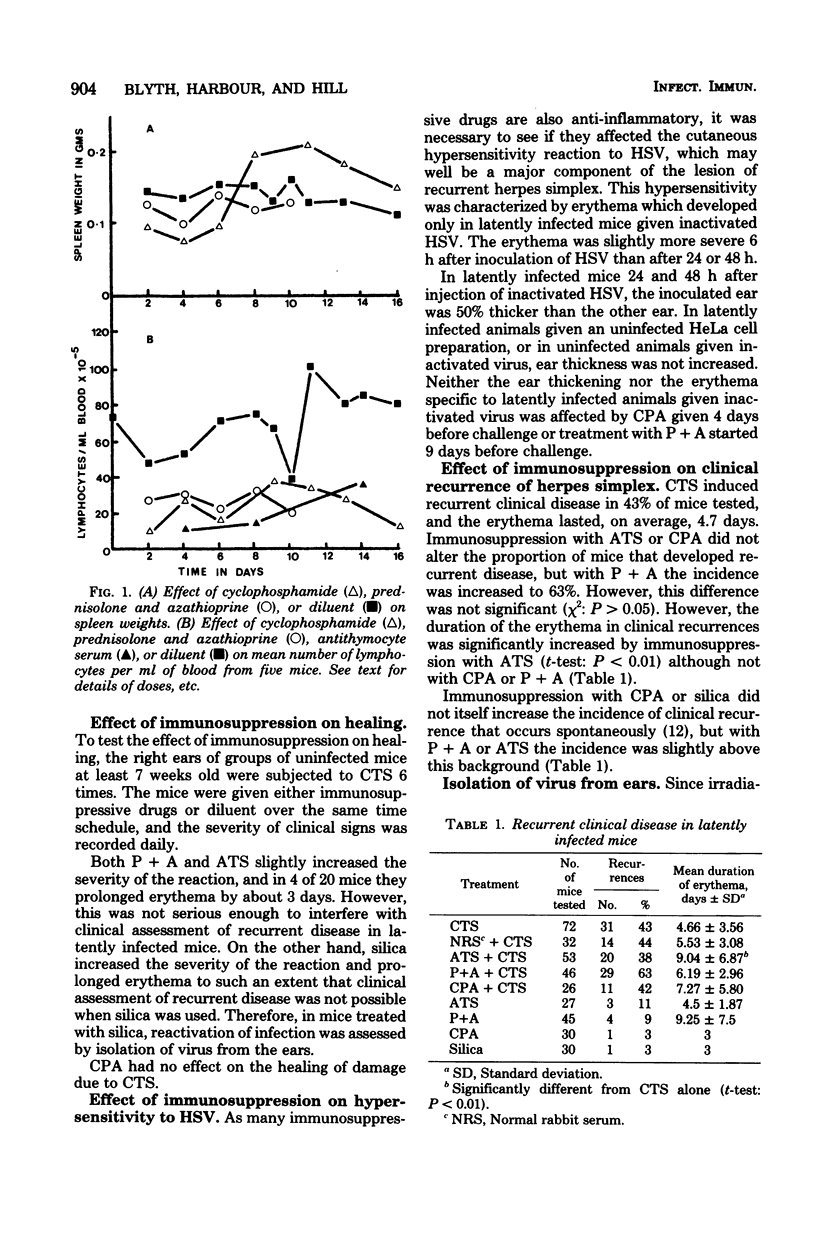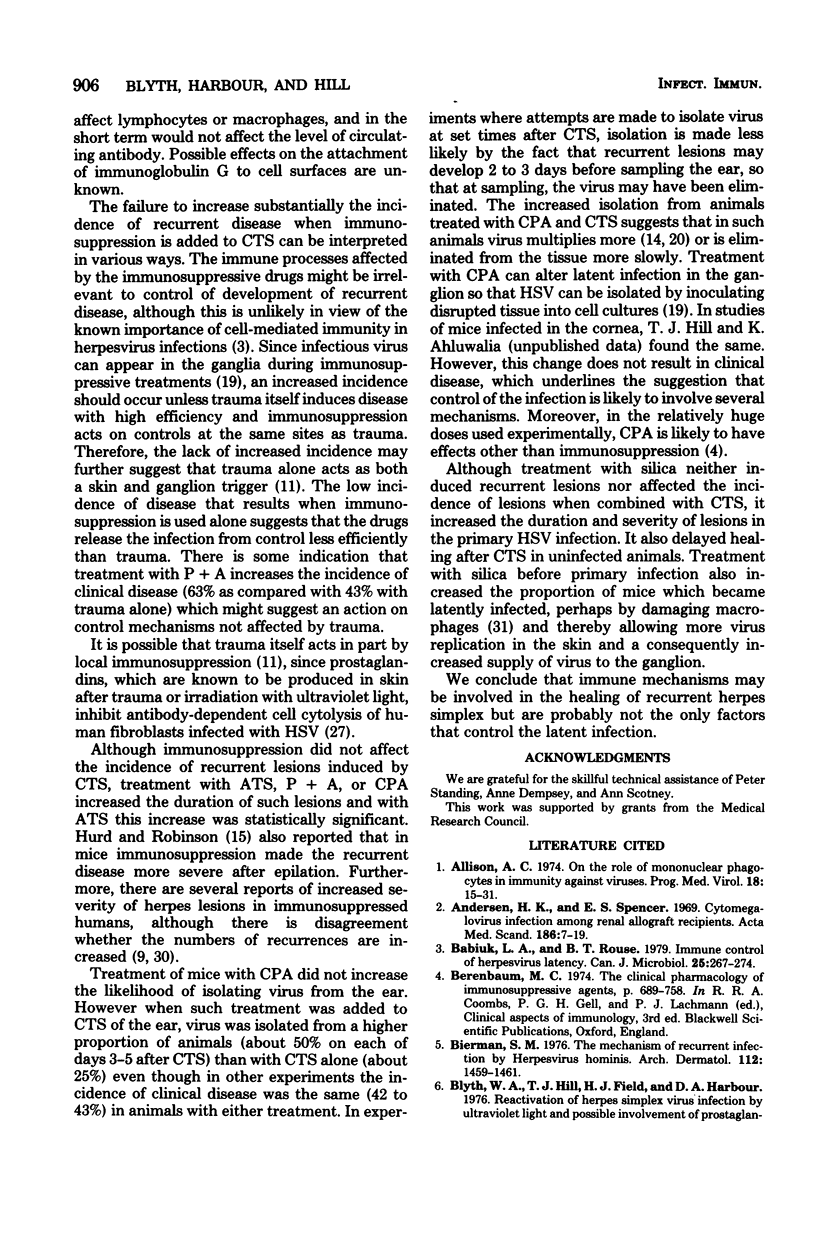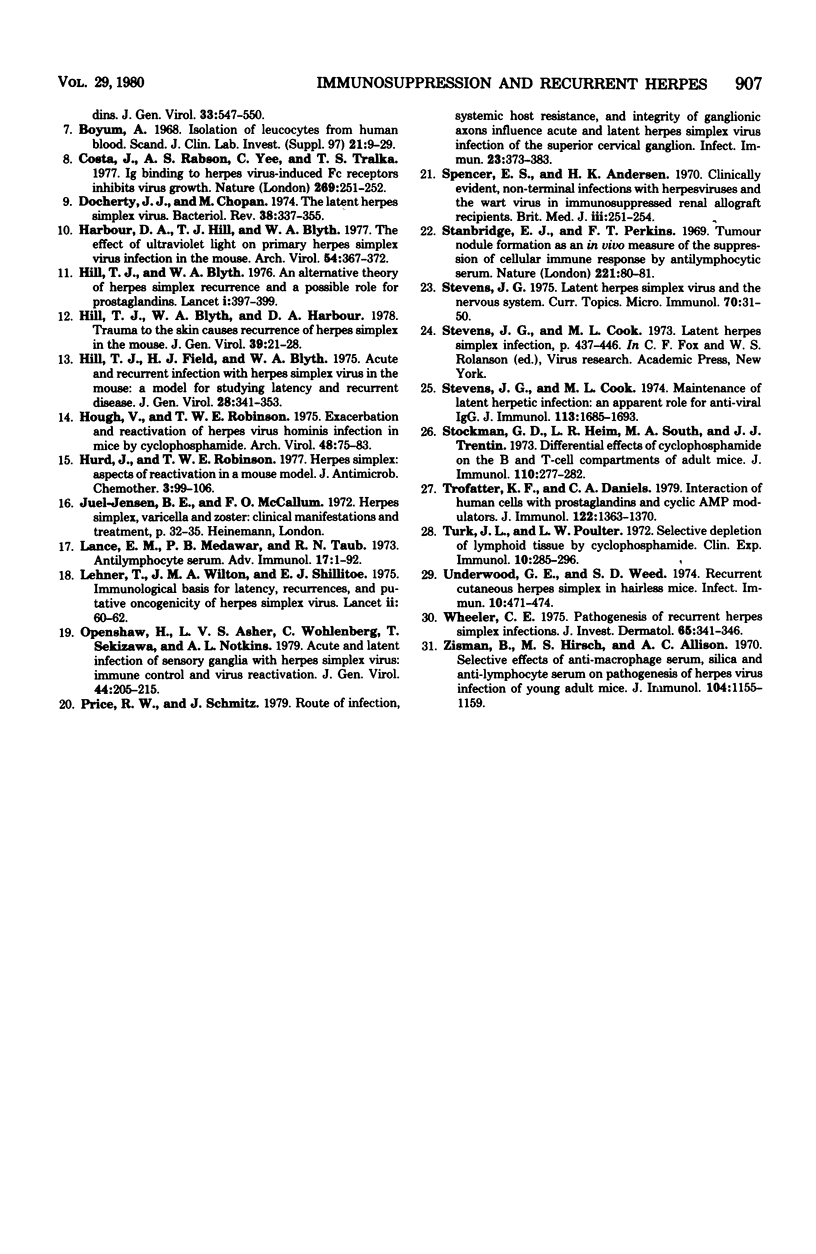Abstract
Mice latently infected with herpes simplex virus were treated with immunosuppressive drugs either alone or combined with stimuli to the skin. Treatment with cyclophosphamide reduced spleen weights and severely depressed lymphocyte levels, but had no effect on healing after cellophane tape stripping (CTS) and did not affect the cutaneous hypersensitivity response after injection of inactivated herpes simplex virus. The drug, either used alone or combined with CTS, failed to increase the incidence of recurrent clinical disease, but increased the incidence of virus isolation after CTS. Prednisolone and azathioprine used together also reduced spleen weights and circulating lymphocyte levels. They slightly delayed healing after CTS, but had no effect on cutaneous hypersensitivity to herpes simplex virus. The treatment, either used alone or combined with CTS, slightly increased the incidence of recurrent clinical disease but did not increase the incidence of virus isolation after CTS. Treatment with antithymocyte serum severely depressed the levels of circulating lymphocytes and delayed the regression of HeLa cell tumors in mice. Used alone, the treatment slightly increased the incidence of recurrent clinical disease, but it failed to increase the incidence of recurrences after CTS. It increased the duration of recurrent herpetic lesions, although in uninfected mice healing after CTS was not affected. Silica altered the clinical course of primary infection with herpes simplex virus and increased the incidence of latency in the ganglia. It also delayed healing after CTS in uninfected mice, so it was not tested when recurrent herpes after CTS was assessed clinically. Treatment with silica alone did not increase the incidence of recurrent clinical disease or the incidence of virus isolation after CTS. The results demonstrate that potent immunosuppressive drugs are much less effective than simple cutaneous manipulation in inducing recurrent lesions, and thus argue strongly for the importance of local factors in the pathogenesis of disease.
Full text
PDF





Selected References
These references are in PubMed. This may not be the complete list of references from this article.
- Allison A. C. On the role of mononuclear phagocytes in immunity against viruses. Prog Med Virol. 1974;18(0):15–31. [PubMed] [Google Scholar]
- Andersen H. K., Spencer E. S. Cytomegalovirus infection among renal allograft recipients. Acta Med Scand. 1969 Jul-Aug;186(1-2):7–19. doi: 10.1111/j.0954-6820.1969.tb01432.x. [DOI] [PubMed] [Google Scholar]
- Babiuk L. A., Rouse B. T. Immune control of herpesvirus latency. Can J Microbiol. 1979 Mar;25(3):267–274. doi: 10.1139/m79-043. [DOI] [PubMed] [Google Scholar]
- Bierman S. M. The mechanism of recurrent infection by Herpesvirus hominis. Arch Dermatol. 1976 Oct;112(10):1459–1461. [PubMed] [Google Scholar]
- Blyth W. A., Hill T. J., Field H. J., Harbour D. A. Reactivation of herpes simplex virus infection by ultraviolet light and possible involvement of prostaglandins. J Gen Virol. 1976 Dec;33(3):547–550. doi: 10.1099/0022-1317-33-3-547. [DOI] [PubMed] [Google Scholar]
- Böyum A. Isolation of leucocytes from human blood. A two-phase system for removal of red cells with methylcellulose as erythrocyte-aggregating agent. Scand J Clin Lab Invest Suppl. 1968;97:9–29. [PubMed] [Google Scholar]
- Costa J., Rabson A. S., Yee C., Tralka T. S. Immunoglobulin binding to herpes virus-induced Fc receptors inhibits virus growth. Nature. 1977 Sep 15;269(5625):251–252. doi: 10.1038/269251a0. [DOI] [PubMed] [Google Scholar]
- Docherty J. J., Chopan M. The latent herpes simplex virus. Bacteriol Rev. 1974 Dec;38(4):337–355. doi: 10.1128/br.38.4.337-355.1974. [DOI] [PMC free article] [PubMed] [Google Scholar]
- Harbour D. A., Hill T. J., Blyth W. A. The effect of ultraviolet light on primary herpes simplex virus infection in the mouse. Arch Virol. 1977;54(4):367–372. doi: 10.1007/BF01314781. [DOI] [PubMed] [Google Scholar]
- Hill T. J., Blyth W. A. An alternative theory of herpes-simplex recurrence and a possible role for prostaglandins. Lancet. 1976 Feb 21;1(7956):397–399. doi: 10.1016/s0140-6736(76)90220-8. [DOI] [PubMed] [Google Scholar]
- Hill T. J., Blyth W. A., Harbour D. A. Trauma to the skin causes recurrence of herpes simplex in the mouse. J Gen Virol. 1978 Apr;39(1):21–28. doi: 10.1099/0022-1317-39-1-21. [DOI] [PubMed] [Google Scholar]
- Hill T. J., Field H. J., Blyth W. A. Acute and recurrent infection with herpes simplex virus in the mouse: a model for studying latency and recurrent disease. J Gen Virol. 1975 Sep;28(3):341–353. doi: 10.1099/0022-1317-28-3-341. [DOI] [PubMed] [Google Scholar]
- Hough V., Robinson T. W. Exacerbation and reactivation of Herpesvirus hominis infection in mice by cyclophosphamide. Arch Virol. 1975;48(1):75–83. doi: 10.1007/BF01320567. [DOI] [PubMed] [Google Scholar]
- Hurd J., Robinson T. W. Herpes virus reactivation in a mouse model. J Antimicrob Chemother. 1977 Mar;3 (Suppl A):99–106. doi: 10.1093/jac/3.suppl_a.99. [DOI] [PubMed] [Google Scholar]
- Lehner T., Wilton J. M., Shillitoe E. J. Immunological basis for latency, recurrences and putative oncogenicity of herpes simplex virus. Lancet. 1975 Jul 12;2(7924):60–62. doi: 10.1016/s0140-6736(75)90499-7. [DOI] [PubMed] [Google Scholar]
- Openshaw H., Asher L. V., Wohlenberg C., Sekizawa T., Notkins A. L. Acute and latent infection of sensory ganglia with herpes simplex virus: immune control and virus reactivation. J Gen Virol. 1979 Jul;44(1):205–215. doi: 10.1099/0022-1317-44-1-205. [DOI] [PubMed] [Google Scholar]
- Price R. W., Schmitz J. Route of infection, systemic host resistance, and integrity of ganglionic axons influence acute and latent herpes simplex virus infection of the superior cervical ganglion. Infect Immun. 1979 Feb;23(2):373–383. doi: 10.1128/iai.23.2.373-383.1979. [DOI] [PMC free article] [PubMed] [Google Scholar]
- Spencer E. S., Andersen H. K. Clinically evident, non-terminal infections with herpesviruses and the wart virus in immunosuppressed renal allograft recipients. Br Med J. 1970 Aug 1;3(5717):251–254. doi: 10.1136/bmj.3.5717.251. [DOI] [PMC free article] [PubMed] [Google Scholar]
- Stanbridge E. J., Perkins F. T. Tumour nodule formation as an in vivo measure of the suppression of cellular immune response by antilymphocytic serum. Nature. 1969 Jan 4;221(5175):80–81. doi: 10.1038/221080a0. [DOI] [PubMed] [Google Scholar]
- Stevens J. G., Cook M. L. Maintenance of latent herpetic infection: an apparent role for anti-viral IgG. J Immunol. 1974 Dec;113(6):1685–1693. [PubMed] [Google Scholar]
- Stevens J. G. Latent herpes simplex virus and the nervous system,. Curr Top Microbiol Immunol. 1975;70:31–50. doi: 10.1007/978-3-642-66101-3_2. [DOI] [PubMed] [Google Scholar]
- Stockman G. D., Heim L. R., South M. A., Trentin J. J. Differential effects of cyclophosphamide on the B and T cell compartments of adult mice. J Immunol. 1973 Jan;110(1):277–282. [PubMed] [Google Scholar]
- Trofatter K. F., Jr, Daniels C. A. Interaction of human cells with prostaglandins and cyclic AMP modulators. I. Effects on complement-mediated lysis and antibody-dependent cell-mediated cytolysis of herpes simplex virus-infected human fibroblasts. J Immunol. 1979 Apr;122(4):1363–1370. [PubMed] [Google Scholar]
- Turk J. L., Poulter L. W. Selective depletion of lymphoid tissue by cyclophosphamide. Clin Exp Immunol. 1972 Feb;10(2):285–296. [PMC free article] [PubMed] [Google Scholar]
- Underwood G. E., Weed S. D. Recurrent cutaneous herpes simplex in hairless mice. Infect Immun. 1974 Sep;10(3):471–474. doi: 10.1128/iai.10.3.471-474.1974. [DOI] [PMC free article] [PubMed] [Google Scholar]
- Wheeler C. E., Jr Pathogenesis of recurrent herpes simplex infections. J Invest Dermatol. 1975 Oct;65(4):341–346. doi: 10.1111/1523-1747.ep12607603. [DOI] [PubMed] [Google Scholar]
- Zisman B., Hirsch M. S., Allison A. C. Selective effects of anti-macrophage serum, silica and anti-lymphocyte serum on pathogenesis of herpes virus infection of young adult mice. J Immunol. 1970 May;104(5):1155–1159. [PubMed] [Google Scholar]


